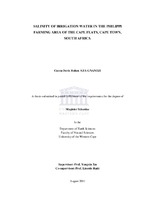| dc.description.abstract | This research investigated the nature, source and the spatial variation of the salinity of the water used for irrigation in the urban farming area of Philippi, which lies in the Cape Flats region of the Cape Town Metropolitan Area, South Africa. The irrigation water is mainly drawn from the Cape Flats aquifer, and pumped into ponds for eventual crop irrigation. Water samples were collected in summer and in winter from fifteen selected sites using standard water sampling procedures. Each site consisted of one borehole and one pond. The samples were routinely analyzed for salinity levels, and concentrations of major and minor ions. From the same boreholes and ponds, water was sampled in summer for isotope analysis to assess effects of evaporation on the water quality and salinity. Descriptive statistics were used to display the variation in range of specific ions in order to compare them with the recommended ranges. Geographical Information Systems analysis described the spatial distribution of the salinity across the study area, and hydrogeochemical analysis characterized the various waters and detected similarities between the water samples in the study area and other waters found in the Cape Flats region. In addition, the US salinity diagram classification of irrigation water developed by Richards (1954) was used to assess the current suitability of groundwater and pond water samples collected during the entire sampling period for irrigation activities. The research indicated that the concentrations of some ions such as chloride, nitrate, potassium and sodium exceeded in places in the study area, the target range values set by the Department of Water Affairs and Forestry (DWAF, 1996) and the Food and Agriculture Organization (Ayers and Westcot, 1985). It revealed that borehole and pond water were mostly brackish across the area regarding their total dissolved salts content, and fresh water was only found in the middle part of the study area. The research found that sea water does not intrude into the aquifer of the study area, and the accumulation of salts in groundwater and soil in the study area is mainly due to the agricultural activities and partially due to the natural movement of water through the geological formation of the Cape Flats region. The conceptual model of the occurrence of the salinization process supported these findings. From this investigation it is understood that the groundwater and pond water in the study area were generally suitable for irrigation purposes but they have to be used with caution as the vegetables are classified as sensitive and moderately sensitive to salt according to DWAF Irrigation water guidelines (1996). The quality of these waters was mainly affected by the land use activities. | en_US |

